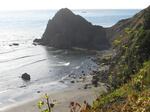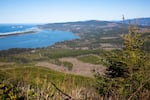They call it the Oregon Way.
When environmentalists and crabbers hashed out a proposal for a new conservation area on the northern Oregon Coast, it led to a rare moment of agreement in a partisan world.
The boundaries originally proposed would have stopped crabbers from accessing sandy-bottom spots at Ecola Point, where prized Dungeness crab are found.
North coast crabbers like John Corbin worked with the group proposing the conservation site. And they moved the boundaries.
“We’ve now got just certain, you know, rocky spots and things that are closed, but the sand and mud bottom and whatever is opened up,” Corbin says, “and it opened up a tremendous amount of area back to fishing again.”
That collaboration is part of a community-led process underway to update state policy for rocky intertidal habitats where sea stars and kelp and shorebirds face an array of threats.
And it all goes back to the Reagan era.

FILE - In this July 17, 1980, file photo, Republican presidential candidate Ronald Reagan stands before a cheering Republican National Convention in Detroit's Joe Louis Arena.
Rusty Kennedy / AP
In Ronald Reagan’s 1980 Republican National Convention speech, he decried federal regulations he said were preventing the development of America’s energy reserves.
“Large amounts of oil and natural gas lay beneath our land and off our shores, untouched,” he said, “because the present administration seems to believe the American people would rather see more regulation, taxes and controls than more energy.”
That set the stage for Reagan’s administration to ask coastal states to plan for offshore oil drilling leases.
But it had been just 13 years since the Santa Barbara oil spill slicked miles of California coastline. Oregonians at public hearings worried about oil in their tidepools. They said no to offshore oil.
Bob Bailey was Oregon’s ocean program coordinator back then.
“We ended up eventually working with the Reagan administration and ultimately the H.W. [Bush] administration to take Oregon and Washington off the lease sale list,” he says.
But Reagan’s oil push actually got Oregon thinking more about protecting its rocky shores.

A view of the shore in Bandon, Ore, on the southern Oregon Coast.
Kate Kaye / JPR News
Bailey helped write the state’s Territorial Sea Plan of 1994, which suggested protective policies for the coast.
“But at the end of the day,” he says, “the state agencies didn’t really do anything with it. You know, it sat for 25 years.”
Now, the state’s Ocean Policy Advisory Council — OPAC — is updating the plan in a way that might lead to taking action.
It doesn’t involve traditional top-down approaches such as executive orders or legislation. Instead, they’ve gone about it the “Oregon Way.” They asked community groups last year to propose coastal sites they’d like to see designated as education, research or conservation areas.
Related: Saving Oregon’s rocky coast: Checking in on the sea stars
An OPAC group is evaluating a dozen of these proposals. Some of them aim to raise awareness of threats to rocky habitats through school curriculum or stewardship programs. Some want more signs at the beach explaining why trampling on tidepools harms intertidal species. Some want rules that would stop drones and kite-flying or limit crab and mussel harvesting.
But coastal policy-making in Oregon hasn’t been easy. People like Bailey have nightmares from the highly contentious marine reserves process of the early 2000s — which pitted advocates for protections against the fishing industry.
“It was unbelievable,” Bailey says, “and I’ve got the scars on my chest to prove that.”
After a grueling battle, the state in 2012 finally created five underwater wilderness areas called marine reserves. Some worry about this current rocky shores process becoming something like Marine Reserves 2.0. So, the hope is to preempt political warfare through better community engagement.
Related: ‘There aren’t a lot of other options:’ Port Orford’s season of crab and crisis
The new proposals will be made available in March for public comment. After that, OPAC members will put the proposals to a vote.
As for Bailey, he’s not involved this time. And he argues the state’s approach is a cop-out.

Netarts Bay is seen from a hilltop in Tillamook County, Ore., Feb. 20, 2020.
Bradley W. Parks / OPB
“I just think it’s people abrogating their responsibilities and avoiding them because it’s too hard,” he says. “Well, my attitude is, suck it up, you’re working on behalf of the public, let’s go.”
But the chair of OPAC’s rocky habitat working group, Charlie Plybon, vouches for the Oregon Way.
“A bottom-up, stakeholder-driven approach is generally the favored way for arriving at these sorts of things,” he says.
Plybon says this process will lead to better community buy-in when it comes time to implement whichever site proposals are approved.
